-
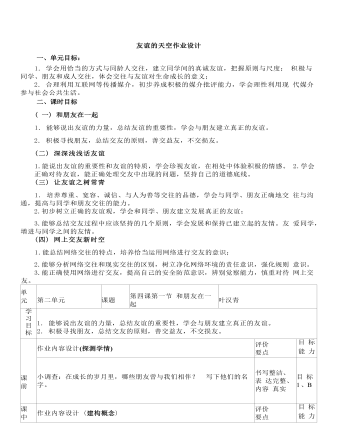
初中道德与法治七年级上册友谊的天空2作业设计
选择题1.打开网页,你可以看新闻、听音乐、玩游戏、交朋友、查资料、购 物、学习等。这从一个侧面说明了 ( )A.网络可以实现我们的一切愿望B.网络交往成为我们生活中不可缺少的部分C.网络生活很丰富D.网络交往是把锋利的双刃剑2. 只要上网,就等于与世界握手。看新闻,办商务、结交朋友、求医 问药、不用舟车劳顿,不用费事周折。这一切说明 ( )A.网络使交流便利,却使人的思想退化B.网络给了很多人可以偷懒的机会C.人们的交往都必须依赖于网络D.网络生活很丰富,网络沟通无极限非常方便、快捷。这说明 ( )A.网络交往超越了空间B.网络交往提高了人们社会活动的质量C.网络交往有利无弊D.网络交往改变了我们的人生价值4.比尔 ·盖茨曾说过:“你甚至不知道和你交流的对方是一条坐在电脑 前会敲击键盘的狗。 ”这说明 ( )3.在小明的众多网友中,有大学生、参加兴趣班的朋友、同学和老师。学习之余,他经常上网聊天;遇到问题,他会在网上向同学和老师请教,
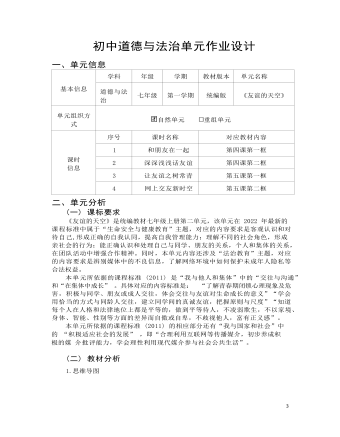
初中道德与法治七年级上册友谊的天空9作业设计
3.下列做法,能使我们在交往中不断完善的有 ( )①不断结识新朋友 ②择其善者而从之,其不善者而改之③结识新朋友,不忘老朋友 ④只和比自己成绩好、家境好的人交朋友。A. ①②④ B. ①②③ C. ②③④ D. ①③④ 4.古人云: “近朱者赤,近墨者黑。 ”这句话表明 ( )①朋友多是好事,朋友越多越好②朋友对一个人的影响很大③结交好的朋友,会使我们受益终身④结交坏的朋友,会使我们染上坏思想、坏毛病A. ①②③ B. ①②④ C. ①③④ D. ②③④ 5.马克思说:“友谊需要忠诚去播种,热情去灌溉,原则去培养,谅解去护理。” 下列观点符合这句话的有 ( )①以真诚换取友谊 ②以热情培养友谊③以宽容维护友谊 ④以原则纯化友谊A. ①②③ B. ①②④ C. ①③④ D.①②③④ 6.说到友谊,很多人都会想到管鲍之交、桃园结义、马克思和恩格斯的革命友 谊……这些友谊穿越时空、流传千古,令人向往。从中我们可以看出 ( )①友谊是人生的宝贵财富 ②益友给我们温暖和力量,让我们感受生活的美好③与朋友在一起总是幸福 ④朋友与我们是亲缘关系,需要彼此忠诚A. ①② B. ①③ C. ②④ D. ③④
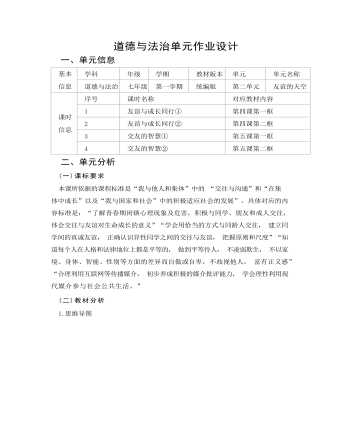
初中道德与法治七年级上册友谊的天空12作业设计
(一)课标要求在 2022 年课标中,要求学生能够与他人进行有效沟通。树立正确的合作与 竞争观念, 真诚、友善, 具有互助精神。 引导学生了解积极交往的意义, 树立主 动交往意识, 积极树立以同情、关爱、道义为基础的友谊。引导学生在交往中积 极践行真诚、友善和互助精神, 提高交往能力,学会处理与自我、他人和集体、 国家和社会等方面关系, 营造良好和谐的人际关系。 了解青春期闭锁心理现象及 危害, 积极与同学、朋友和成人交往, 体会交往与友谊对生命成长的意义。学会 用恰当的方式与同龄人交往, 建立同学间的真诚友谊, 正确认识异性同学之间的 交往与友谊, 把握原则与尺度。知道每个人在人格和法律地位上都是平等的, 做 到平等待人, 不凌弱欺生, 不以家境、身体、智能、性别等方面的差异而自傲或 自卑, 不歧视他人, 富有正义感。合理利用互联网等传播媒介, 初步养成积极的 媒介批评能力,学会理性利用现代媒介参与社会公共生活。

初中道德与法治七年级上册友谊的天空3作业设计
11.材料一:王某在校外结识了一群哥们,总是他们相约去网吧,彻夜不归玩游戏,还 聚众打架。某日,他们相约到路边向低年级同学敲诈勒索,被人当场抓获并扭送公安机关。材料二:小英性格内向,不爱与人交流,但她在同桌小红的影响下,逐渐开始活泼起来, 在班级里结交了不少朋友。(1) 王某、小英发生上述变化的原因分别是什么?(2) 结合材料一和材料二,谈谈你对友谊的理解。12.我和小莉是形影不离的好朋友,可是有一次学校举办演讲比赛,我们都报了名,但 是小莉被选上了,我却没有。从此,我心中有了“心结” ,不愿再与小莉说话了。后来我在 网上认识了小 A,我们之间无话不谈、志趣相投。某日小 A 向我借钱,我答应了,他很快就 还给我了。于是,我更加坚信他是值得相信的朋友。后来,他再找我借钱,我又一次借给了 他,但没想到, 自此以后,他仿佛消失了一般,再也没有联系过我。伤心的我,把这事告诉了小莉,小莉建议我在家长的陪同下去报警并陪我渡过那段伤心 的时光,从此我们的友谊更加坚固。(1) 如果你是材料中的“我” ,你落选时朋友小莉却被选中参赛,你会怎么做?请说 明原因。(2) 材料启示我们,结交网友时需要注意什么?
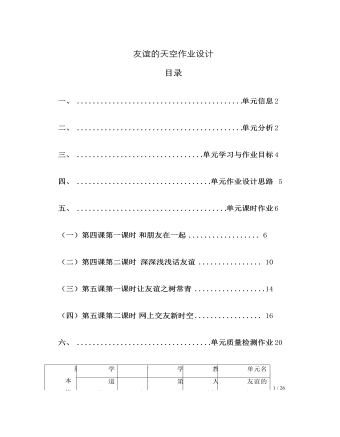
初中道德与法治七年级上册友谊的天空4作业设计
(1) 请结合所学知识,谈谈你对“幸福、幸运”的理解。【看法二】小李:“我最近和好朋友发生了矛盾,考试时他问我答案,我拒绝 了他,他很生气。拒绝给他答案,我这样做是不是做错了?我感觉我们两个 人已经渐行渐远了,我该怎么办?”(2) 面对小李的苦恼,你会如何开导、安慰他?【看法三】小王:“我身边很多同学都是通过送礼物、花钱请吃饭来巩固友情 的,要不我也模仿他们吧。”(3) 花钱请客吃饭能买到真正的友谊吗?请运用所学知识谈谈你的理解。12. (原创题)阅读材料,回答下列问题。七年级学生肖楠在交友遇到了很多困扰:困扰一:我发现好朋友小鹏愁眉苦脸,关心地上前询问原因,可小鹏怎么也 不肯说,还对我很不耐烦。困扰二:我和网友轻舞飞扬在网上认识一年多,很投缘,他想要我的照片, 想知道我的姓名、学校、家庭住址等信息,还想约我周末见面。
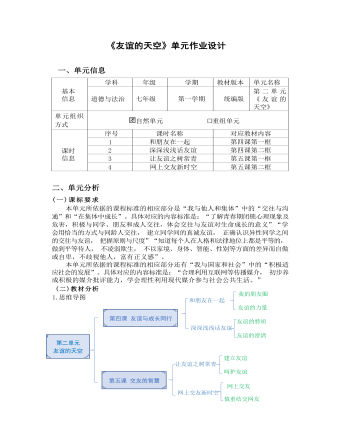
初中道德与法治七年级上册友谊的天空10作业设计
2.内容内在逻辑《友谊的天空》是人教版七年级道德与法治上册的第二单元。该单元从思想品 德课程的生活性原则出发, 引领学生在日益扩大的交往中正确认识友谊、把握友 谊,为他们自身的健康成长营造良好的人际关系提供指导。本单元由单元导言和第四课“友谊与成长同行”、第五课“交友的智慧”组 成。第四课、第五课各设两框。单元导言用诗意的语言揭示出友谊带来的丰富感 受以及对学生成长的意义,旨在引发学生的共鸣,激发学生探究本单元的愿望。第四课围绕友谊的作用和探讨友谊展开。 第一框 “和朋友在一起”,主要介 绍了友谊是重要的人际关系和心理需要, 帮助学生认识友谊在成长中的作用; 第 二框 “深深浅浅话友谊”帮助学生认识友谊的特质, 澄清对友谊可能存在的模糊 认识。第五课从行为上指导学生正确交友。 第一框 “让友谊之树常青”引导学生探 讨如何建立友谊和呵护友谊; 第二框 “网上交友新时空”帮助学生正确认识网络 交往的特点理清网上交往的利弊。把握好网上人际交往的原则, 扩大交友的范围, 提升交友的能力。
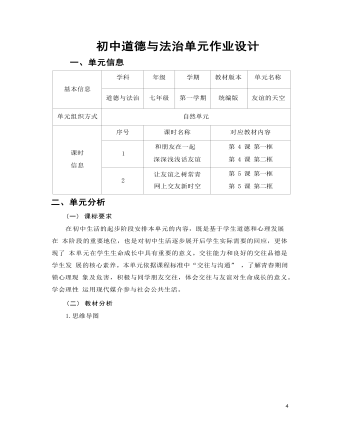
初中道德与法治七年级上册友谊的天空14作业设计
A.因为朋友,我们感受到自己的价值B.因为朋友,我们感受到友谊的力量C.因为朋友,我们获得了更多的荣誉D.因为朋友,我们会乐于并尝试学习9.朋友之间需要忠诚和信任,但是,这并不意味着朋友之间就应该毫无保留。我们关心和帮助朋友,但不要替朋友作决定。由此可见 ( )A.呵护友谊,需要给对方一些空间B.呵护友谊,需要用心体会对方的需要C.冲突发生时,要相互协调和宽容D.友谊的力量让我们得到健康的成长10.七年级的乐乐同学迷上网络游戏后,学习成绩一落千丈。他从此变得孤僻,不爱说话,易发脾气。后来,他的同桌亮亮与他交往,和他做朋友,他们经 常一起做作业、讨论问题,一起打球。乐乐慢慢远离网络游戏,学习勤奋了,有进步了,性格变得开朗了。这一事例表明 ( )A.友谊帮助我们认识和改正自己言行中的缺失,使人进步B.友谊使人远离网络C.朋友可以改变人的一切D.朋友使我们对任何事情都敢去尝试
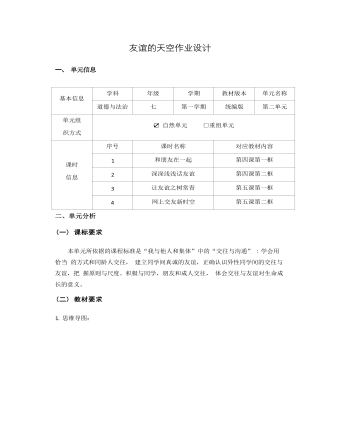
初中道德与法治七年级上册友谊的天空作业设计
7、在班级, 你无意中听到好朋友把你的秘密告诉了别人, 正确的处理方法是( )A.忍气吞声, 毕竟是朋友,如果直说估计就做不成朋友了B.把对方的秘密也告诉别人,以牙还牙C.要么选择宽容,寻找彼此能接受的解决方式,要么就冷静地结束友谊D.我要去质问他/她:我把你当作知心朋友,你却不能像我一样严守秘密, 我很生气也很失 望 8、考试中,你的好朋友有道题目不会做想请你“帮忙”时,你选择了“拒绝”。事后,好朋友不 理睬你了。这时你的正确做法是 ( )A .不“帮忙”不是自己的错,你不理我,我也不理你B . 向他道歉,表示以后再有“机会”一定多“帮忙”C .编造个借口,说那道题自己当时还没做出来D .选择时机心平气和地与他沟通,告诉他考试作弊是违反纪律的事。
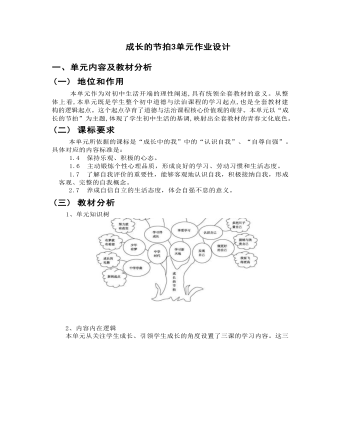
初中道德与法治七年级上册成长的节拍3作业设计
( 一) 活动步骤1.全班分为4 各小组:绘画组, 日记组,网络组,实践组。每个小组设置 1 名小组长。 我列出了四项作业供每个学习小组选做,之后课上分享展示学习成果。(1) 调查中学时代对一个人的重要性或者人生影响 (可以调查周围的亲朋好友 也可以调查小区的人) 。调查结果写心得体会或者写报告,深刻认识到中学时代 对一个人的重要性。 (实践组)(2) 走出安逸区,真正的成长是有艰辛和汗水造就的,列出自己的目标、学习 习惯的行动和计划。对自己的学习习惯进行深刻分析后制订了习惯养成计划表, 每天对照执行。学生可以请求同学和家长经常提醒、监督自己,以养成良好的习 惯,改正缺点,做更好的自己,实现自己的目标。 (绘画组)(3) 编写自己的成长手册 (自评、他评、老师评价) ,记录你的奋斗目标你的 想法和创意,让他见证和助推你的成长。 ( 日记组)(4) 负责记录,拍照,将活动内容传到 QQ 群里,写这一单元的活动小报。 (网 络组)(二) 时间要求:15 分钟
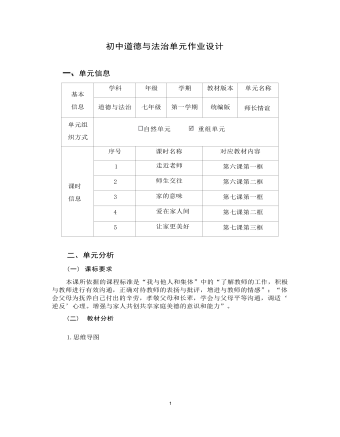
初中道德与法治七年级上册师长情谊9作业设计
2.内容内在逻辑承接上一单元中学会和同伴交往,本单元则是帮助学生正确处理师生关系、 亲子关系和家庭关系,是人际交往的继续和延伸。师长是中学生成长中的“重要他人” ,学生和师长的关系如何,直接影响到学 习和生活的质量。到了青春期以后,随着青少年自我意识的凸显,他们要求摆脱 依赖、走向自立的愿望和行动增强,有时会和师长产生冲突。教材不回避青少年 成长可能带来的各种冲突与矛盾,在尊重学生的独立愿望、成长需要的基础上, 引导他们走近师长,看冲突背后“爱”的流动,通过主动对话和交流达成相互理解。第六课第一框题 主要是在情感上引导学生去主动了解老师、 尊重老师、 亲近老师; 乐于接纳并尊重不同风格的老师。能够以恰当的方式表达对老师的情感;学会接纳不同风格的老师;提高提炼信息和语言表达的能力。了解教师的 工作特点,理解教师工作的特殊性;理解存在不同风格教师的原因;知道不同的 教师具有不同的风格。
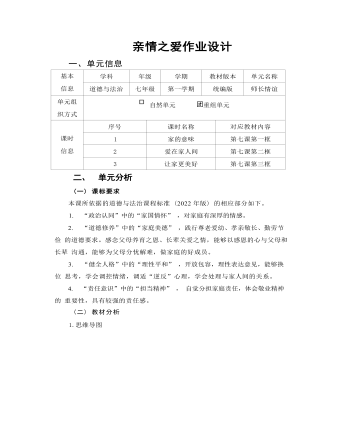
初中道德与法治七年级上册亲情之爱2作业设计
(一) 课标要求本课所依据的道德与法治课程标准 (2022 年版) 的相应部分如下。1. “政治认同”中的“家国情怀” ,对家庭有深厚的情感。2. “道德修养”中的“家庭美德” ,践行尊老爱幼、孝亲敬长、勤劳节俭 的道德要求。感念父母养育之恩、长辈关爱之情,能够以感恩的心与父母和长辈 沟通,能够为父母分忧解难,做家庭的好成员。3. “健全人格”中的“理性平和” ,开放包容,理性表达意见,能够换位 思考,学会调控情绪,调适“逆反”心理,学会处理与家人间的关系。4. “责任意识”中的“担当精神” , 自觉分担家庭责任,体会敬业精神的 重要性,具有较强的责任感。(二) 教材分析1.思维导图2. 内容内在逻辑第七课《亲情之爱》是七年级上册第三单元第二部分内容。在介绍与同学、 朋友、老师交往的基础上,要求学生认识、了解家庭,学会与家人交往。
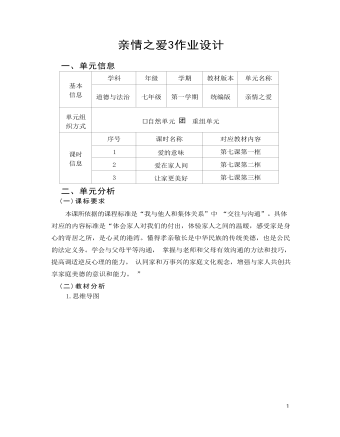
初中道德与法治七年级上册亲情之爱3作业设计
【答案】 (1) 反映了微信、 微博等现代沟通手段影响家庭成员之间的生活与 交流方式。一些子女随着年龄的增长反感父母的过度关注,故意设置障碍将父母 屏蔽,影响了与父母的沟通与交流。(2) ①在家庭中,家人之间有着不同的价值观念和生活方式,这些差异可能 带来家庭成员间的矛盾和冲突,影响家庭和谐。 ②这需要家庭成员之间互相信 任、体谅和包容。 ③有效的交流和沟通,可以增进理解,化解矛盾和冲突。 ④孝 亲敬长,要从小事做起,细致入微的关怀,要亲近父母,主动与父母进行沟通。【设计意图及分析】第 (1) 问考查与父母的交流问题,从微信、 微博等影响 家庭成员之间的交流方式,一些子女反感父母的过度关注,故意设置障碍将父母 屏蔽,影响了与父母的交流等角度作答。第 (2) 问考查建设和谐美好家庭的要 求,从家庭成员冲突的原因;化解冲突需要家庭成员之间互相信任、体谅和包 容;交流和沟通;孝亲敬长,要从小事做起,亲近父母,主动与父母交流;用良 好心态面对家庭发生的变化等角度作答。
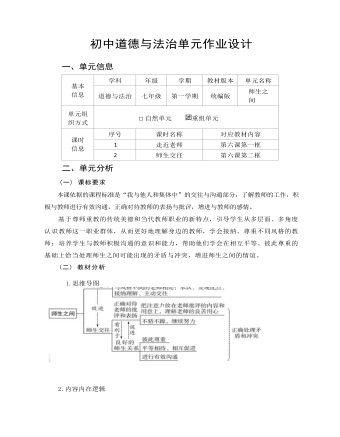
初中道德与法治七年级上册师生之间作业设计
第六课“师生之间”是七年级上册第三单元第一课。本课基于初中学生自我意识 增强、思维能力发展的特点,着力处理青春期的独立性与依赖性的矛盾,帮助学生深 入认识和理解自己的老师。在感受老师对自己的关爱和教育的同时,学会主动关心、 帮助老师,与老师建立一种良好的师生关系。本课与第七课“亲情之爱”内容继承了 孝亲敬长的中华传统美德,落实了社会主义核心价值观的基本内容,指引学生正确处 理师生关系、亲子关系和家庭关系,是初中学生人际交往的拓展与延伸。第一框“走近老师”,从教师的职业特点和责任使命等角度,引导学生进一步了解 老师,理解老师的不易,培养尊敬老师的情感,学会积极接纳不同风格的老师,为学 习第二框的内容奠定情感基础。第二框“师生交往”,引导学生懂得“教学相长”的道理,强调师生之间的双向互动,引导学生正确对待老师的引领和指导,全面认识师生交往的实质,努力建立和谐 的师生关系,达到师生交往理想而美好的状态。

初中道德与法治七年级上册成长的节拍作业设计
2.内容内在逻辑本单元是七年级上册教材的第一单元, 作为对初中生活开端的理性阐述,具 有统领全套教材的意义。从整体上看, 本单元既是整个初中道德与法治课程的学 习起点, 也是全套教材建构的逻辑起点。这个起点包孕了道德与法治课程核心价 值观的萌芽。第一课《中学时代》也是整个初中生活开始的第一课, 可谓是重中 之重。第一框“中学序曲”共两课时。 主要引领学生踏着成长的节拍, 体会角色变 化的意味,了解中学时代对于人生的意义和价值。第二框“少年有梦”共两课时。主要帮助学生为未来的生活确立崭新的目标, 编织梦想,建立努力就有改变的生活信念,并且为实现中国梦奠定基础。(三)学情分析告别小学, 刚跨进中学大门, 开启一段全新的生命成长旅程。他们朝气蓬勃、 活力四射、思维活跃, 但是认知能力、思维方式、人格特点及社会经验等都有待 于进一步发展; 由于每个人的成长经历、个性心理等方面存在差异, 所以他们的 实际表现也各不相同。
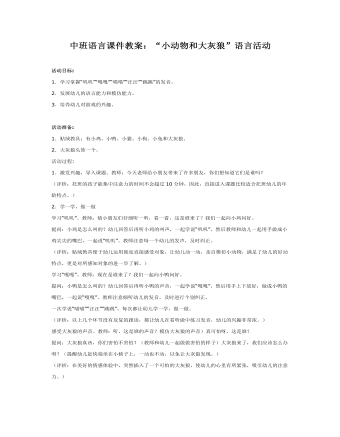
中班语言课件教案:“小动物和大灰狼”语言活动
2.发展幼儿的语言能力和模仿能力。3.培养幼儿对游戏的兴趣。 活动准备:1.贴绒教具:有小鸡、小鸭、小猫、小狗、小兔和大灰狼。2.大灰狼头饰一个。活动过程:1.激发兴趣,导入课题。教师:今天老师给小朋友带来了许多朋友,你们想知道它们是谁吗?(评析:托班的孩子能集中注意力的时间不会超过10分钟,因此,直接进入课题比较适合托班幼儿的年龄特点。)2.学一学,做一做学习“叽叽”。教师:情小朋友们仔细听一听,看一看,这是谁来了?我们一起向小鸡问好。提问:小鸡是怎么叫的?幼儿回答后再听小鸡的叫声,一起学说“叽叽”。然后教师和幼儿一起用手做成小鸡尖尖的嘴巴,一起说“叽叽”。教师注意每一个幼儿的发声,及时纠正。(评析:贴绒教具便于幼儿运用视觉直接感受对象,让幼儿动一动,亲自模仿小动物,满足了幼儿的好动特点,更是对所感知对象的进一步了解。)学习“嘎嘎”。教师:现在是谁来了?我们一起向小鸭问好。提问:小鸭是怎么叫的?幼儿回答后再听小鸭的声音,一起学说“嘎嘎”,然后用手上下放好,做成小鸭的嘴巴,一起说“嘎嘎”。教师注意倾听幼儿的发音,及时进行个别纠正。一次学说“喵喵”“汪汪”“跳跳”,每次都让幼儿学一学,做一做。(评析:以上几个环节没有反复的跟读,都让幼儿在看听做中练习发音,幼儿的兴趣非常浓。)感受大灰狼的声音。教师:听,这是谁的声音?模仿大灰狼的声音)真可怕呀,这是谁?
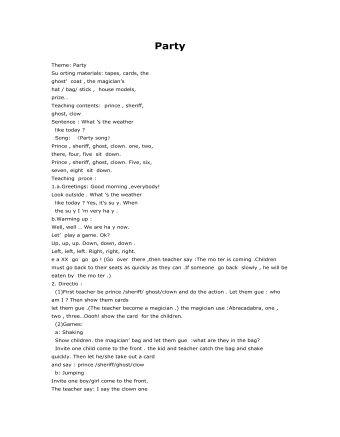
大班英语教案:Party
prize… Teaching contents: prince , sheriff, ghost, clow Sentence : What ’s the weather like today ? Song: 《Party song》 Prince , sheriff, ghost, clown. one, two, there, four, five sit down. Prince , sheriff, ghost, clown. Five, six, seven, eight sit down. Teaching proce : 1.a.Greetings: Good morning ,everybody!
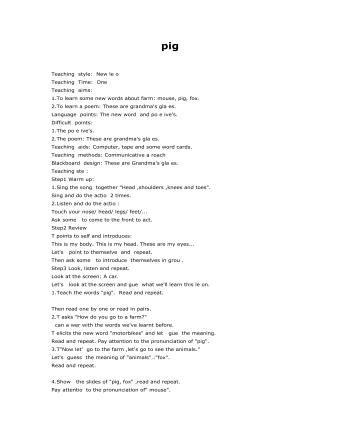
大班英语教案:pig
1.To learn some new words about farm: mouse, pig, fox. 2.To learn a poem: These are grandma's glaes. Language points: The new word and po eive's. Difficult points: 1.The po e ive's. 2.The poem: These are grandma's gla es. Teaching aids: Computer, tape and some wordcards. Teaching methods: Communicative aroach Blackboard design: These are Grandma's glaes. Teaching ste : Step1 Warm up: 1.Sing the song together "Head,shoulders ,knees and toes". Sing and do the actio 2 times.

大班英语教案:Finger
二. Activity content:1.会说finger2.听懂What’s this?三.Activity aims: 1.让幼儿听懂并学会finger 2.让幼儿知道手指的作用,有保护和清洁手的意识.四.Activity materials:手电筒一个,手指娃娃五个,广告颜料若干,大白纸四张(上面画好了大小不等的圆形),抹布四块
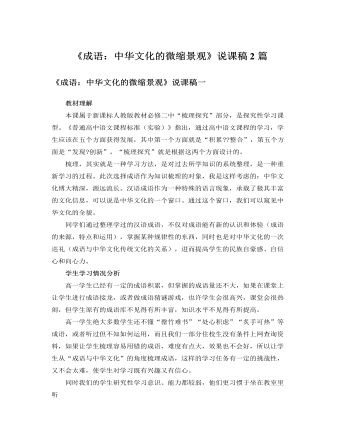
人教版高中语文必修2《成语:中华文化的微缩景观》说课稿2篇
(三)教学目标1、明确成语的来源,了解成语的结构特点。2、学习积累成语的方法。3、梳理学习过的成语,做到能正确理解、使用所学的常用成语。(四)教学重点和难点1、学习积累成语的方法。2、正确理解、使用所学的常用成语。二、说教法新的《高中语文课程标准》要求学生主动去发现问题、解决问题,教师是课堂学习的组织者、参与者,是课堂的主导,而不是课堂的主体。而且,新的课程标准要求学生“能围绕所选择的目标加强语文积累,在积累的过程中,注重梳理”。在这种前提下,本节课可以采取以下方法:由于这种梳理是对学生已有的知识进行归纳分类,可能显得比较枯燥。为了避免这种枯燥感,可以采取设置情境和分组竞答的方法,调动学生的积极性。
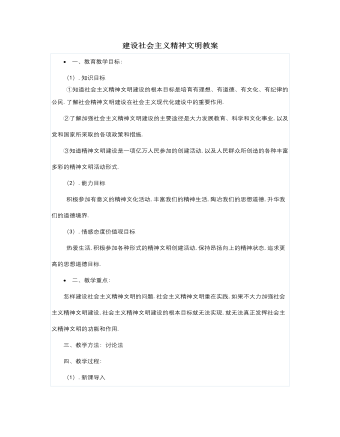
人教版高中政治必修3建设社会主义精神文明教案
师:三亚目前正在强调打造文化产业,如举办文体大赛,提升三亚知名度.如今"美丽三亚,浪漫天涯"已成为三亚一张旅游名片,以文化产业的发展带动经济旅游的发展,大家结合今天的三亚文化产业发展谈谈发展文化事业和文化产业的作用.学生:回答(略)。师:要支持文化产业发展,增强我国文化产业的整体实力和竞争力.? 3. 亿万人民的创建活动(板书) (1).人民群众是精神文明创建活动的主体。学生朗读课文P103页,理解亿万人民是精神文明创建活动的主体.师:发展先进文化,本质上是一个立足于建设中国特设社会主义伟大实践而不断进行文化创造的过程,也就是社会主义精神文明的创建过程.(2).人民群众参与精神文明创建活动的意义.师:人民群众在社会主义精神文明建设活动中,创造了丰富多彩的形式,在参与的过程中思想感情得到熏陶,思想觉悟得到启发,精神生活得到充实,道德意识得到增强,道德境界得到升华.这对整个中华民族的精神面貌,正在产生不可估量的积极影响.





















